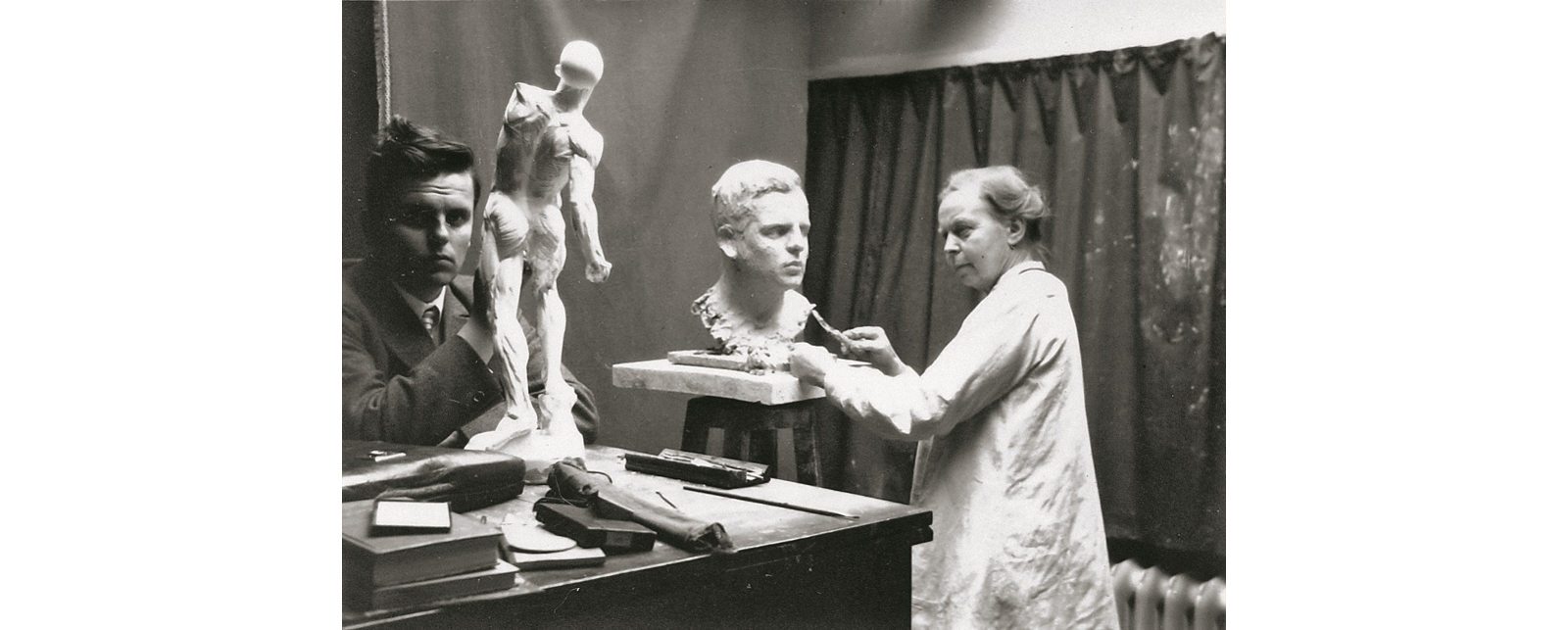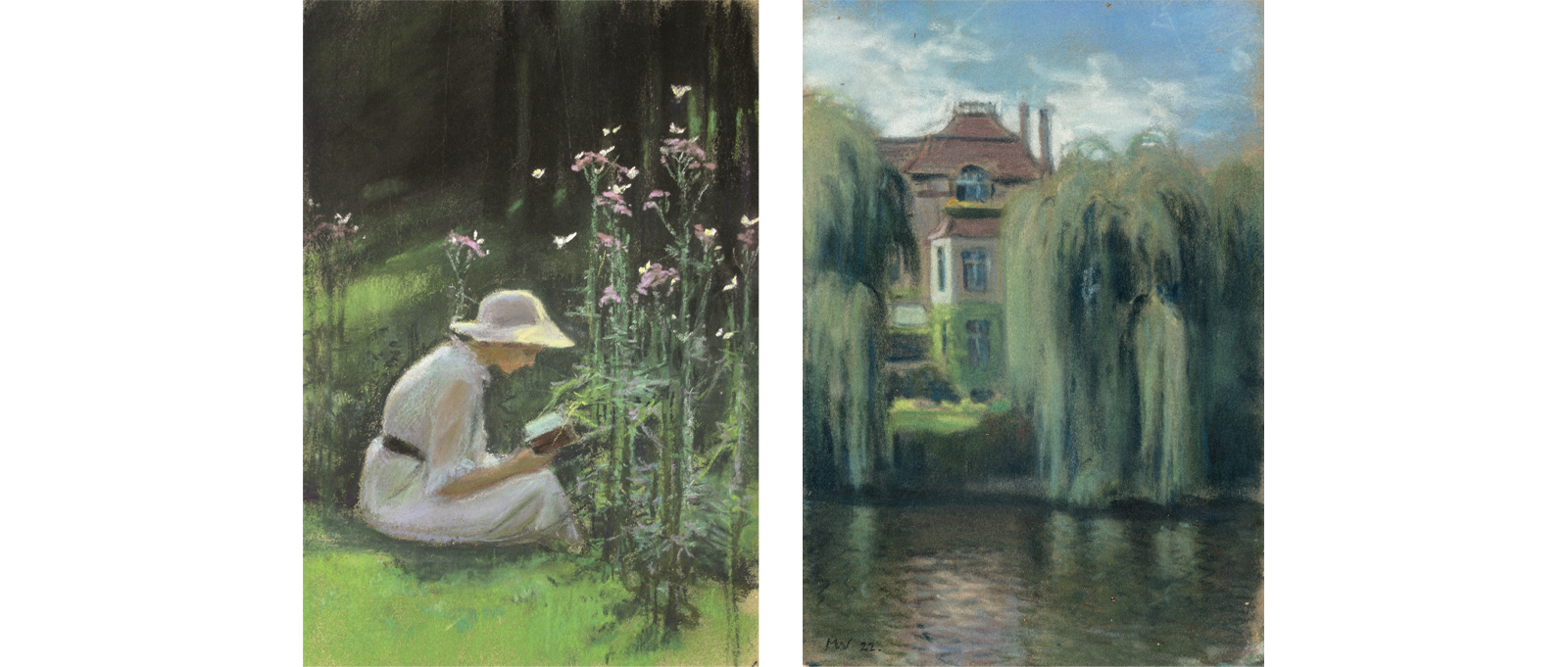Mary Hertz Warburg: Free and Unconventional
Review of the Hamburg Exhibition at the Ernst-Barlach-Haus, February/June 2022
by Giacomo Calandra di Roccolino
Abstract
The Books […] threatened to suffocate the daily life of the family.
His wife, a woman of refined sensibilities, who, as a talented sculptor,
would have had the right to have a space for her own work,
took note of the situation and dealt with it with touching patience
Fritz Schumacher

1 | Mary Warburg portaying her son-in-law Peter Paul Braden, 1928, Warburg Institute Archive, London.
The exhibition Auf Augenblicke frei und glücklich MARY WARBURG (1866-1934) – on display until 12 June at the Barlach Haus in Hamburg – is dedicated to the figure of Mary Warburg, née Hertz. The exhibition is based on the 2020 monograph Mary Warburg. Portrait einer Künstlerin. Leben/Werk, curated by Bärbel Hedinger and Michael Diers with Andrea Völker (presented in Engramma 177) which illustrated Warburg’s oeuvre through numerous essays and a commented catalogue of her works. Staged in the splendid setting of the park of Villa Jenisch, the exhibition is a homage to the artist and displays around fifty selected works, including drawings, pastels and plastic works, covering a period of five decades, during which Warburg’s artistic ambitions asserted themselves repeatedly against social conventions and family commitments. The fact that Mary was the life companion of a scholar like Aby Warburg (1866-1929), both eminent and complex, did not allow her personality and talent to fully emerge. They remained confined to a small circle of friends, not permitting her work to be appreciated outside the borders of the Hanseatic city. Mary Hertz trained without attending public schools or academies, but took advantage of the opportunities offered in her private sphere in Hamburg: from the age of 16, she attended painting lessons with some of the most important artists, including several women, such as Agnes Steiner or Valeska Röver.
As the daughter of a senator from the Free Hanseatic City of Hamburg, she had to attend official and public events in her mother’s stead, who suffered from Parkinson’s disease at an early age. From 1882 onwards, she undertook several trips with her father, thus having the opportunity to practise drawing en plein air: the views that she collected in a number of notebooks are displayed in the exhibition. In her evocative travel pictures, her views of Hamburg in impressionistic colours and her portraits of family and friends, she shows to be a sensitive observer with a trained eye and an experienced hand. It was during one of these trips that Mary met Aby Warburg, with whom she fell in love to the extent that she defied social and religious conventions in order to marry him. She came from a family of ancient Protestant tradition, while Warburg was the eldest son of the city’s most important Jewish family. Mary and Aby married in 1897 and immediately moved to Florence, where Aby continued his studies, living in the Potetje Palace. Some famous watercolours of the palace and its interior are among the most interesting exhibits.
Despite her three children and numerous other commitments, Mary was able to pursue her career as an artist, partly thanks to Alfred Lichtwark, director of the Hamburg Kunsthalle, who held her in high regard and became her first promoter. She participated in numerous exhibitions where she sold some of her works, although she always remained absolutely free to follow her own artistic interests. Along with Hamburg’s most prominent personalities, she came in contact with other important artists of her time, such as the Berliner Käthe Kollowitz, whom she met in 1902 during an exhibition at the Kunstverein. We do not know whether she came into direct contact with the expressionist Ernst Barlach, to whom the museum that houses the current exhibition is dedicated. However, the museum has managed to create a link between the two artists by displaying Barlach’s design for the funerary monument for another branch of the Warburg family in the last room of the permanent exhibition.
Particularly interesting are the drawings and sculptures from which her symbiotic relationship with Aby Warburg emerges, such as the beautiful bust of their daughter Marietta (1899-1973) as a child, drawings illustrating Aby’s work and some publications illustrated by Mary. On the other hand, the plaster models made by Mary Warburg to study the lighting of the elliptical room of the Kulturwissenschaftliche Bibliothek Warburg (presented in Engramma 116) did not find space.

2 | Mary Warburg, Lesende Frau am Waldrand, 1902. Crayon on paper, 26,7 x 18,5 cm. Mary Warburg legacy at Hamburger Kunsthalle, photo by Andrea Völker.
3 | Mary Warburg, Warburg’s garden at Heilwigstraße 114 seen from the other side of the Alster, 1922. Crayon on Paper, 22,5 x 15,6 cm. John und Kay Prag Collection, photo Andrea Völker.
Finally, one cannot fail to say a few words about the building that welcomes the exhibition. The construction of the Barlach-Haus was financed by the Hamburg industrialist Hermann F. Reemtsma, who had begun collecting the works of the expressionist sculptor and painter Ernst Barlach in 1934. With the advent of Nazism, Barlach’s works were judged as degenerate art and he was banned from exhibiting and working from 1938. Reemtsma supported the artist until his death in 1938 with the purchase of 20 sculptural works and about 100 drawings. The museum, built between 1961 and 1962 by the Hamburg architect Werner Kallmorgen (1902-1979), is a remarkable example of functionalist architecture, as well as fulfilling its function of enhancing the works on display without overpowering them.

4 | Ernst-Barlach-Haus inside the park of Jenisch Haus. photo by Hagen Stier, Hamburg.
Abstract
This contribution by Calandra di Roccolino, is the review of the exhibition Auf Augenblicke frei und glücklich MARY WARBURG (1866-1934), on display at the Barlach Haus in Hamburg until 12 June. The exhibition is intended to be a homage to the artist Mary Warburg, Aby’s wife, and displays around fifty selected works, including drawings, pastels, and plastic works, covering a period of five decades.
keywords | Mary Warburg Hertz; Ernst-Barlach-Haus; Hamburg.
Per citare questo articolo / To cite this article: G. Calandra di Roccolino, Mary Hertz Warburg: Free and Unconventional, “La Rivista di Engramma” n. 191, aprile-maggio 2022, pp. 179-182 | PDF of the article